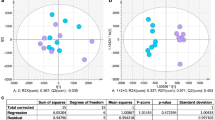Abstract
Toxicokinetics of methyl mercury were studied in pigs after intravenous (i.v.) administration of the compound. The distribution of methyl mercury was slow taking 3–4 days to be completed. Blood elimination half-life was found to be 25 days. The apparent volume of distribution was 9.8 l/kg indicating pronounced tissue accumulation of methyl mercury. Highest mercury levels were found in kidney and liver, with lower contents in muscle and brain and very little in adipose tissue. The results indicate that from organs like liver and kidney methyl mercury is eliminated much more slowly than from the blood. Over a period of 15 days 16% of the dose administered was excreted with faeces and 0.9% in the urine.
Similar content being viewed by others
References
Abdulla M, Arnesjö B, Ihse I (1974) Methylation of mercury in intestinal diseases (in Swedish). Läkartidningen 71: 810–812
Aberg B, Ekman L, Falk R, Greitz U, Persson G, Snihs J-O (1969) Metabolism of methyl mercury (203Hg) compounds in man. Arch Environ Health 19: 478–484
Baggot JD (1977) Principles of drug disposition in domestic animals: The basis of veterinary clinical pharmacology. WB Saunders, Philadelphia
Beije B, Arrhenius E (1978) Influence of cystein deficiency on the inhibition of hepatic microsomal detoxication by methyl mercury in two rat strains. Chem Biol Interact 21: 167–178
Berlin M (1963) Renal uptake, retention and excretion of mercury. II. A study in the rabbit during infusion of methyl- and phenylmercuric compounds. Arch Environ Health 6: 626–633
Curley A, Sedlak VA, Girling EF, Hawk RE, Barthel WF (1971) Organic mercury identified as the cause of poisoning in humans and hogs. Science 172: 65–67
Hawryshyn CW, Mackay WC (1979) Toxicity and tissue uptake of methylmercury administered intraperitoneally to rainbow trout. Bull Environ Contam Toxicol 23: 79–86
Hilmy MI (1978) Toxicity of organic mercury in sheep and hens. Clin Toxicol 12: 445–456
Iverson F, Downie RH, Trenholm HL, Paul C (1974) Accumulation and tissue distribution of mercury in the guinea pig during subacute administration of methyl mercury. Toxicol Appl Pharmacol 27: 60–69
Mehra M, Kanwar KC (1980) Absorption, distribution and excretion of methylmercury in mice. Bull Environ Contam Toxicol 24: 627–633
Methyl mercury in fish. A toxicologic-epidemiologic evaluation of risks. (1971) Nord Hyg T [Suppl 4], Stockholm
Miettinen JK, Rahola T, Hattula T, Rissanen L, Tillander M (1971) Eliminatiom of 203Hg-methylmercury in man. Ann Clin Res 3: 116–122
Naganuma A, Imura N (1979) Methylmercury binds to a low molecular weight substance in rabbit and human erythrocytes. Toxicol Appl Pharmacol 47: 613–616
Naganuma A, Koyama Y, Imura N (1980) Behaviour of methylmercury in mammalian erythrocytes. Toxicol Appl Pharmacol 54: 405–410
Neathery MW, Miller WJ, Gentry RP, Stake PE, Blackmon DM (1974) Cadmium — 109 and methyl mercury — 203 metabolism, tissue distribution, and secretion into milk of cows. J Dairy Sci 57: 1177–1183
Nordberg GF, Berlin MH, Grant CA (1971) Methyl mercury in the monkey — autoradiographical distribution and neurotoxicity. Proc Int Congr Occup Health 16: 234–237
Norseth T (1971) Biotransformation of methyl mercuric salts in the mouse studied by specific determination of inorganic mercury. Acta Pharmacol Toxiol 29: 375–384
Norseth T (1973) Biliary excretion and intestinal reabsorption of mercury in the rat after injection of methyl mercuric chloride. Acta Pharmacol Toxicol 33: 280–288
Norseth T, Clarkson TW (1970) Biotransformation of methylmercury salts in the rat studied by specific determination of inorganic mercury. Biochem Pharmacol 19: 2775–2783
Norseth T, Clarkson TW (1971) Intestinal transport of 203Hg-labeled methyl mercury chloride. Arch Environ Health 22: 568–577
Salvaterra P, Massaro EJ, Morganti JB, Lown BA (1975) Time-dependent tissue/organ uptake and distribution of 203Hg in mice exposed to multiple sublethal doses of methyl mercury. Toxicol Appl Pharmacol 32: 432–442
Sell JL, Davison KL (1975) Metabolism of mercury, administered as methylmercuric chloride or mercuric chloride by lactating ruminants. J Agric Food Chem 23: 803–808
Stake PE, Neathery MW, Miller WJ, Gentry RP (1975) 203Hg excretion and tissue distribution in Holstein calves following single tracer intravenous dosis of methyl mercury chloride or mercuric chloride. J Anim Sci 40: 720–726
Suzuki T (1969) Neurological symptoms from concentration of mercury in the brain. In: Miller MW, Berg GG (eds) Chemical fallout. Current research on persistent pesticides. Thomas, Springfield, pp 245–257
Swensson Å, Ulfvarson U (1963) Toxicology of organic mercury compounds used as fungicides. Occup Health Rev 15: 5–11
Swensson Å, Ulfvarson U (1968a) Distribution and excretion of various mercury compounds after single injections in poultry. Acta Pharmacol Toxicol 26: 259–272
Swensson Å, Ulfvarson U (1968b) Distribution and excretion of mercury compounds in rats over a long period after a single injection. Acta Pharmacol Toxicol 26: 273–283
Swensson Å, Ulfvarson U (1969) Investigations on the toxic effects of different mercury compounds on young White Leghorn cocks. J Poulty Sci 48: 1567–1574
Ulfvarson U (1962) Distribution and excretion of some mercury compounds after long term exposure. Int Arch Gewerbepathol 19: 412–422
Ulfvarson U (1970) Transportation of mercury in animals. Stud Labor Salut 6: 1–63
Vermeer K (1971) A survey of mercury residues in aquatic bird eggs in the Canadian Prairie provinces. Trans N Am Wildl Conf 36: 138–149
Vostal J (1972) Blood distribution and biliary excretion of methyl mercury. Abstracts XVIII Int Congress Occup Health, Buenos Aires, Argentina, p 26
WHO (1972) Evaluation of certain food additives and the contaminants mercury, lead, and cadmium. World Health Org Tech Rep Ser 505: 14–24
WHO (1974) The use of mercury and alternative compounds as seed dressings. World Health Org Tech Rep Ser 555
Willes RF (1977 Tissue distribution as a factor in species susceptibility to toxicity and hazard assessment; example: Methylmercury. J Environ Pathol Toxicol 1: 135–146
Author information
Authors and Affiliations
Rights and permissions
About this article
Cite this article
Gyrd-Hansen, N. Toxicokinetics of methyl mercury in pigs. Arch Toxicol 48, 173–181 (1981). https://doi.org/10.1007/BF00310486
Received:
Issue Date:
DOI: https://doi.org/10.1007/BF00310486




